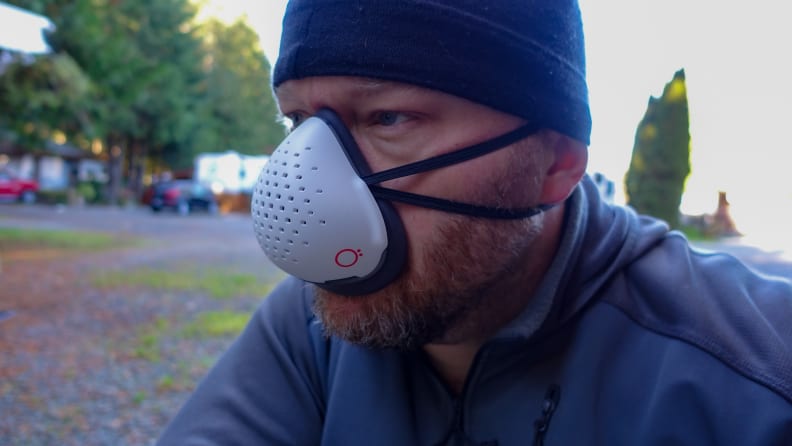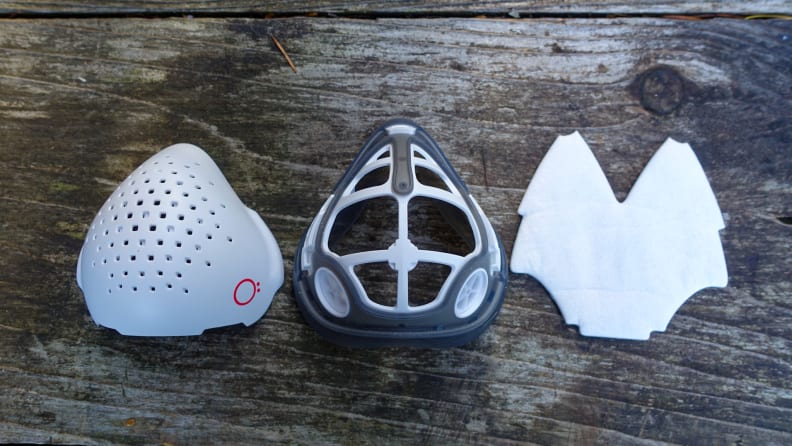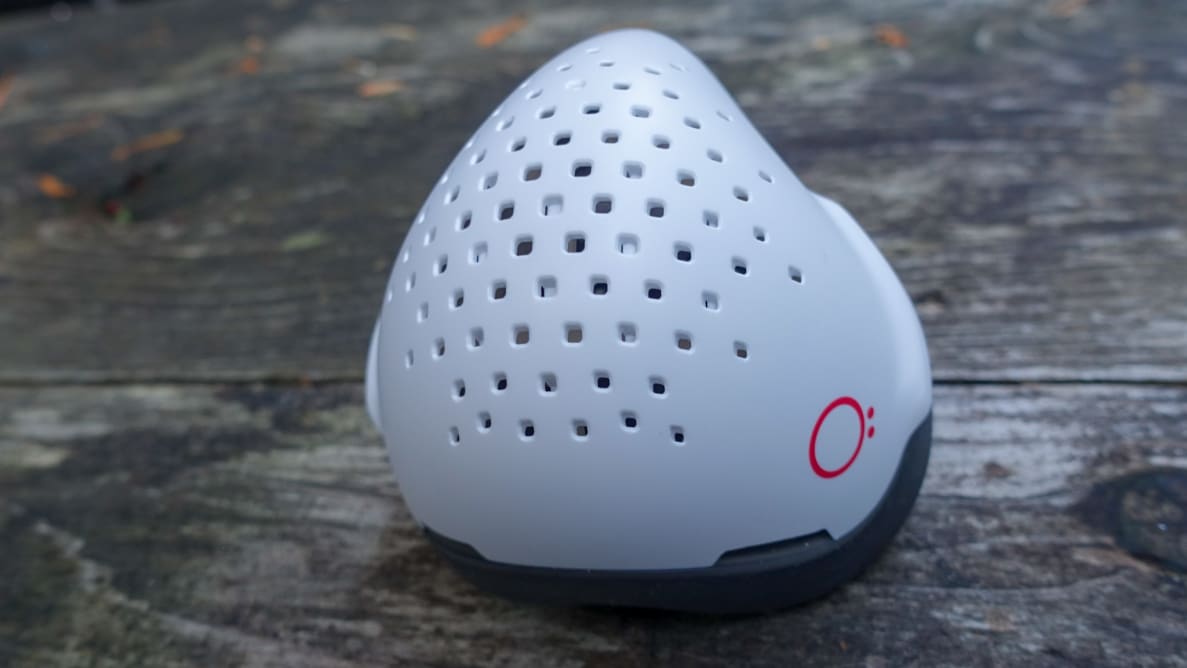Pros
-
Comfortable
-
Tight seal against the face
-
More protection than cloth or paper masks
Cons
-
High consumables cost
-
Awkward-looking
-
Not as effective as an N95 mask
What’s a Respirator?
Paper and cloth masks don’t provide a tight seal between their edges and your face. This means that while they offer some protection against COVID-19 when social distancing isn’t an option, some of the droplets that carry the virus can still get into your lungs or out into the world. In contrast, a respirator is designed to fit snugly against your face, keeping more of what you breathe out away from others and more of what others exhale, away from you.
Design

The O2 Curve might look awkward, but its design is pretty ingenious.
There’s no kind way to say it: the O2 Curve looks like an athletic cup. It’s the first thought I had when I unboxed it and, after sending her a selfie of me wearing it, it was the first thing my wife told me when she got home from work. While worn, the respirator's plastic and silicone frame provides a triangle of protection from the top of the nose to just below the mouth. Its aesthetic is easy to forgive, however, as its smaller size makes it easier to maintain that all-important seal against the wearer’s skin. Additionally, as the respirator doesn’t cover the chin, it can comfortably be donned while wearing a bicycle or motorcycle helmet, with its chin-strap secured.
The silicon trim that lines the inside edge of the O2 Curve created a tight seal against my skin. The respirator is held tightly in place by padded, elastic ear loops, which can be adjusted to fit most people. Sadly, I am not most people—my skull is absolutely massive. When wearing the O2 Curve using the ear loops it ships with, I found the respirator uncomfortable to wear for an extended period of time. Switching the ear loops out for O2’s optional sport strap made wearing the O2 Curve significantly more comfortable. Further customization can be found in the fact that O2 Industries ships their respirator sized either for high-bridged noses or low-bridged noses.
The respirator ships with a white plastic cone that, when attached, sandwiches the respirator’s replaceable filter material between it and the O2 Curve’s silicon and plastic frame. If white’s not your color, you can buy a replacement shell from O2 industries in black, blue, or red.
Filtration

The respirator can be taken apart when the time comes to change its filter.
It’s important to note that this respirator was originally made to protect commuters and folks working in dusty or smokey environments, not slowing viral transmission. As such, its design includes two one-way valves, located at the base of the respirator. These valves allow your exhaled breath to escape, putting those around you at greater risk of infection in the unfortunate event that you’ve got COVID-19. To mitigate this, O2 Industries will soon be selling silicone valve plugs to ensure that the only air that gets out of the mask does so through the respirator’s filter. I was able to take these plugs for a spin during testing and found that, while condensation from my breath quickly built up inside of the mask, there was no discernible difference in how comfortably I was able to breath. That said, filtration materials don’t typically do well when exposed to moisture. If you’re wearing the respirator with the valve plugs installed, you might want to change your filter out more frequently.
O2 Industries sells replacement filters through their online shop, available either as a one-off purchase or via a monthly subscription. Buying filters obviously raises the cost of the respirator’s ownership, over time. However, investing in disposable surgical masks or buying fabric face coverings will put you out-of-pocket, too.
As to its effectiveness at filtering out the air pollution and viral matter that could do you harm, O2 Industries' website states that the “...O2 Curve filters are designed to filter with greater than 99% efficiency down to a particle size of 0.1 µm, and independent lab testing confirmed filter efficiency of greater than 99% with particle sizes from 0.1 to 0.5 µm, using a flow rate of 236 L / min.” The company’s documentation goes on to say that the filter material used in their respirators have “...a virus filtration efficiency of 99.998%, with a mean particle size of 2.7 µm, and used a 31 nm (0.03 µm) virus.” The SARS-COV2, (COVID-19) particles are estimated to be 120 nm (0.12 µm) in size.
This is more science than my head is ok with. So, I asked Reviewed’s Senior Scientist, Julia MacDougall, to explain it in terms that I could understand. She told me, in plain English, that the filters should block far more particles than any cloth or disposable paper mask can, but can’t block particles as small as N95 materials are certified to do.
Does it Work?
I haven’t contracted COVID-19 yet. But this likely has more to do with my living in relative seclusion and following strict protocols designed to keep me alive than the O2 Curve. I’ve got a heart condition that places me well within the range of high-risk individuals for the virus, so I’m pretty cautious. However, this past September, there wasn’t anything I could do to escape the smoke from California’s wildfires.
As the amount of smoke in the air increased, I found it harder to breathe which, in turn, screwed with my heart rate—something my cardiologist wasn’t cool with. I did what I could to stay safe, by staying indoors and keeping our windows closed, but the problems persisted. After a few days of putting up with this, my O2 Curve sample arrived. I wore it for hours on the first day and found that my symptoms began to subside. I then took the respirator off that night and went to bed. When I woke up, I found that my symptoms had returned. Over the next few days, I wore the O2 Curve almost constantly, including when I went to bed, changing out the filter, every other day. While wearing it full-time wasn’t the most comfortable experience, it was preferable to the physical distress I was in.
Should You Buy It?
What personal protective equipment you invest in is a very personal choice based on your needs and budget. I’m not in a position to provide you with medical advice of any kind. However, there’s an advantage to owning a respirator that protects better than cloth or paper, but not quite as well as the N95 masks many of us wish we had an endless supply of. I liked knowing that the O2 Curve’s seal, filter, and valve plugs helped keep those around me safe while protecting me from airborne droplets and pollution.
Maybe you will, too.
Meet the tester
Séamus Bellamy was a senior editor on Reviewed's Electronics Team. After returning to freelancing, he now writes for them. Before coming to Reviewed, his work was featured in The New York Times, The Globe & Mail, BBC World, Macworld, and Maximum PC.
Checking our work.
Our team is here to help you buy the best stuff and love what you own. Our writers, editors, and experts obsess over the products we cover to make sure you're confident and satisfied. Have a different opinion about something we recommend? Email us and we'll compare notes.
Shoot us an email

